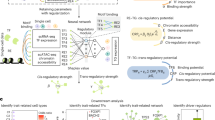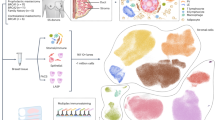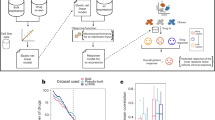Abstract
Cancer cell lines are used in many biomedical research laboratories. Why, then, are they often described as unrepresentative of the cells from which they were derived? Here, I argue that they have been unjustly accused. Under the right conditions, and with appropriate controls, properly authenticated cancer cell lines retain the properties of the cancers of origin.
This is a preview of subscription content, access via your institution
Access options
Subscribe to this journal
Receive 12 print issues and online access
$189.00 per year
only $15.75 per issue
Buy this article
- Purchase on Springer Link
- Instant access to full article PDF
Prices may be subject to local taxes which are calculated during checkout

Similar content being viewed by others
References
O'Hare, M. J. in Human Cancer in Primary Culture (ed. Masters, J. R. W.) 271– 286 (Kluwer Academic, Dordrecht, 1991).
Hsu, M.-Y., Elder, D. A. & Herlyn, M. in Human Cell Culture Volume 1, Cancer Cell Lines Part 1 (eds Masters, J. R. W. & Palsson, B.) 259– 274 (Kluwer Academic, Dordrecht, 1999).
Lansford, C. D. et al. in Human Cell Culture Volume 2, Cancer Cell Lines Part 2 (eds Masters, J. R. W. & Palsson, B.) 185–255 (Kluwer Academic, Dordrecht, 1999).
Fogh, J., Fogh, J. M. & Orfeo, T. One hundred and twenty-seven cultured human tumour cell lines producing tumours in nude mice. J. Natl Cancer Inst. 59, 221–226 (1977).
Wistuba, I. I. et al. Comparison of features of human breast cancer cell lines and their corresponding tumours. Clin. Cancer Res. 4, 2931–2938 (1998).
Wistuba, I. I. et al. Comparison of features of human lung cancer cell lines and their corresponding tumours. Clin. Cancer Res. 5, 991–1000 (1999).
Drexler, H. G. Review of alterations of the cyclin-dependent kinase inhibitor INK4 family genes p15, p16, p18 and p19 in human leukemia-lymphoma cells. Leukemia 12, 845–859 ( 1998).
Drexler, H. G. et al. p53 alterations in human leukemia-lymphoma cell lines: in vitro artefact or prerequisite for cell immortalization? Leukemia 14, 198–206 ( 2000).
Ross, D. T. et al. Systematic variation in gene expression patterns in human cancer cell lines. Nature Genet. 24, 227 –235 (2000).
Walker, M. C., Parris, C. N. & Masters, J. R. W. Differential sensitivities to chemotherapeutic drugs between testicular and bladder cancer cells. J. Natl Cancer Inst 79, 213–216 ( 1987).
Knuechel, R. & Masters, J. R. W. in Human Cell Culture Volume 1, Cancer Cell Lines Part 1 (eds Masters, J. R. W. & Palsson, B.) 213–230 (Kluwer Academic, Dordrecht, 1999).
UKCCCR guidelines for the use of cell lines in cancer research. Br. J. Cancer 82, 1495– 1509 (2000).
Dirks, W. G., MacLeod, R. A. F. & Drexler, H. G. ECV304 (endothelial) is really T24 (bladder carcinoma): cell line cross-contamination at source. In Vitro Cell Dev. Biol. Anim. 35, 558–559 ( 1999).
Gartler, S. M. Genetic markers as tracers in cell culture. Natl Cancer Inst. Monogr. 26, 167–195 ( 1967).
Gold, M. A Conspiracy of Cells. One Woman's Immortal Legacy and the Scandal It Caused (State University of New York, Albany, 1986).
Nelson-Rees, W. A., Flandermeyer, R. R. & Hawthorne, P. K. Banded marker chromosomes as indicators of intraspecies cellular contamination. Science 184, 1093 (1974).
Nelson-Rees, W. A., Daniels, D. W. & Flandermeyer, R. R. Cross-contamination of cells in culture. Science 212, 446–452 ( 1981).
Gey, G. O., Coffman, W. D. & Kubicek, M. T. Tissue culture studies of the proliferative capacity of cervical carcinoma and normal epithelium. Cancer Res. 12, 264–265 (1952).
Markovic, O. & Markovic, N. Cell cross-contamination in cell cultures: the silent and neglected danger. In Vitro Cell Dev. Biol. Anim. 34, 1–8 ( 1998).
MacLeod, R. A. F. et al. Widespread intraspecies cross-contamination of human tumour cell lines. Int. J. Cancer 83, 555– 563 (1999).
MacLeod, R. A. F. & Drexler, H. G. in Human Cell Culture Volume 3, Leukemias and Lymphomas (eds Masters, J. R. W. & Palsson, B.) 373–399 (Kluwer Academic, Dordrecht, 2000).
Povey, S., Hopkinson, D. A., Harris, H. & Franks, L. M. Characterisation of human cell lines and differentiation from HeLa by enzyme typing. Nature 264, 60– 63 (1976).
O'Toole, C. M., Povey, S., Hepburn, P. & Franks, L. M. Identity of some human bladder cancer cell lines. Nature 301, 429–430 (1981).
Gilbert, D. A. et al. Application of DNA fingerprints for cell line individualization . Am. J. Hum. Genet. 47, 499– 514 (1990).
Freshney, R. I. Culture of Animal Cells. A Manual of Basic Technique 4th edn (Wiley-Liss, New York, 2000).
Drexler, H. G. & Uphoff, C. C. in The Encyclopedia of Cell Technology (eds Spier, R. E., Griffiths E. & Scragg, A. H.) 609–627 (Wiley, New York, 2000).
Hay, R. J., Macy, M. L. & Chen, T. R. Mycoplasma infection of cultured cells. Nature 339, 487–499 ( 1989).
Virmani, A. K. et al. Promoter methylation and silencing of the retinoic acid receptor-β gene in lung carcinomas. J. Natl Cancer Inst. 92, 1303–1307 (2000).
Virmani, A. K. et al. Allelotyping demonstrates common and distinct patterns of chromosomal loss in human lung cancer types. Genes Chrom. Cancer 21, 308–319 ( 1998).
Shivapurkar, N. et al. Multiple regions of chromosome 4 demonstrating allelic losses in breast carcinomas. Cancer Res. 59, 3576 –3580 (1999).
Masters, J. R. W. & Lakhani, S. How microarrays can help cancer patients. Nature 404, 921 (2000).
Alizadeh, A. A. et al. Distinct types of diffuse large B-cell lymphoma identified by gene expression profiling. Nature 403, 503–511 (2000).
Schaeffer, W. I. Usage of vertebrate, invertebrate and plant cell, tissue and organ culture terminology. In vitro 20, 19– 24 (1984).
Jat, P. S. & Sharp, P. A. Cell lines established by a temperature-sensitive simian virus 40 large-T-antigen are growth restricted at the nonpermissive temperature. Mol. Cell. Biol. 9, 1672– 1681 (1989).
Stamps, A. C., Davies, S. C., Burman, J. & O'Hare, M. J. Analysis of proviral integration in human mammary epithelial cell lines immortalized by retroviral infection with a temperature-sensitive SV40 T-antigen construct . Int. J. Cancer 57, 865– 874 (1994).
Simon, L. V., Beauchamp, J. R., O'Hare, M. & Olsen, I. Establishment of long-term myogenic cultures from patients with Duchenne muscular dystrophy by retroviral transduction of a temperature-sensitive SV40 large T antigen. Exp. Cell Res. 224, 264– 271 (1996).
Thomson, J. A., Pilotti, V., Stevens, P., Ayres, K. L. & Debenham, P. G. Validation of short tandem repeat analysis for the investigation of cases of disputed paternity. Forensic Sci. Int. 100, 1–16 ( 1999).
Acknowledgements
I thank Alan Entwistle, Ludwig Institute for Cancer Research, University College London for help preparing the time-lapse movies and Jim Thomson, Laboratory of the Government Chemist, London, UK for providing images for Figure 1.
Author information
Authors and Affiliations
Supplementary information
LNCaP (prostate)
Images collected by Alan Entwistle (Ludwig Institute for Cancer Research, Royal Free and UCL Branch) and John Masters.
Related links
Rights and permissions
About this article
Cite this article
Masters, J. Human cancer cell lines: fact and fantasy. Nat Rev Mol Cell Biol 1, 233–236 (2000). https://doi.org/10.1038/35043102
Issue Date:
DOI: https://doi.org/10.1038/35043102
This article is cited by
-
Hallmark discoveries in the biology of Wilms tumour
Nature Reviews Urology (2024)
-
The pharmacoepigenomic landscape of cancer cell lines reveals the epigenetic component of drug sensitivity
Communications Biology (2023)
-
Establishment and characterization of a new intrahepatic cholangiocarcinoma cell line derived from a Chinese patient
Cancer Cell International (2022)
-
Salivary gland organoid culture maintains distinct glandular properties of murine and human major salivary glands
Nature Communications (2022)
-
Establishment and characterization of a new Chinese hepatocellular carcinoma cell line, Hep-X1
Human Cell (2022)



